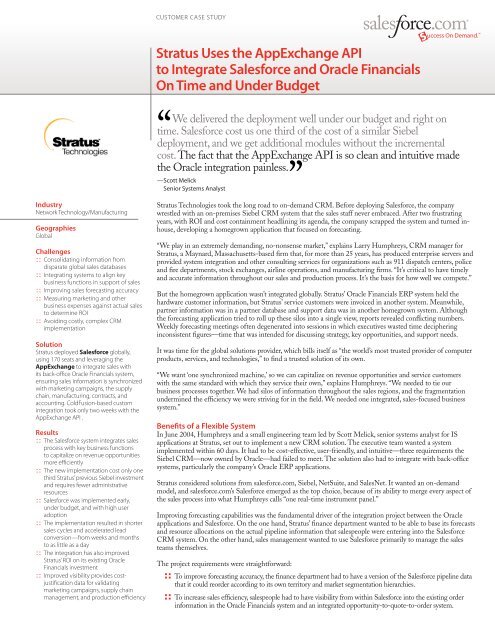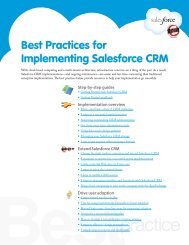Case Study: Stratus Uses AppExchange API to Integrate Salesforce ...
Case Study: Stratus Uses AppExchange API to Integrate Salesforce ...
Case Study: Stratus Uses AppExchange API to Integrate Salesforce ...
- No tags were found...
Create successful ePaper yourself
Turn your PDF publications into a flip-book with our unique Google optimized e-Paper software.
Havingone integratedinstrument panelvalidates our effortsevery step of theway. <strong>Salesforce</strong> givesus constant visibilityin<strong>to</strong> our salesprocess. We knowwhere we’re gettingleads, how quicklywe’re closing deals,and how efficientlywe’re executingorders. We knowif we’re spendingmoney wisely.— Larry Humphreys,CRM Manager The <strong>AppExchange</strong> Solution<strong>Stratus</strong>’ solution was <strong>to</strong> replicate the <strong>Salesforce</strong> Opportunities data in<strong>to</strong> a local, on-premises database. Financialinformation from Oracle Financials was then appended <strong>to</strong> this <strong>Salesforce</strong> data. This effectively created aunified data model based on Opportunities that finance could use for forecasting and which would also beavailable <strong>to</strong> the homegrown order management system known as ftQuote. Once an order is approved, thesystem updates and locks down the information in both <strong>Salesforce</strong> and the Oracle system.<strong>Stratus</strong> built the integration with Adobe ColdFusion (formerly Macromedia). “Everything is seamless,” saysMelick. “Our integration is at the order opportunity level. We pass opportunity information <strong>to</strong> ftQuote, ourColdFusion-based quoting <strong>to</strong>ol. When the order is submitted, this information is passed on <strong>to</strong> the OracleERP applications. Then, when the order number is created, it is passed back <strong>to</strong> <strong>Salesforce</strong>.”The key <strong>to</strong> <strong>Salesforce</strong>’s integration capabilities is the <strong>AppExchange</strong> application programming interface(<strong>API</strong>), a Web services interface that provides direct, low-level access <strong>to</strong> all data s<strong>to</strong>red in <strong>Salesforce</strong>. Based onopen Internet standards, the <strong>AppExchange</strong> <strong>API</strong> allows developers <strong>to</strong> access <strong>Salesforce</strong> from within virtuallyany programming language, development environment, or integration <strong>to</strong>ol. Using the <strong>AppExchange</strong> <strong>API</strong>,cus<strong>to</strong>mers can import and export data from <strong>Salesforce</strong> <strong>to</strong> ERP systems, deliver real-time sales and supportinformation <strong>to</strong> company portals, and populate critical business systems with cus<strong>to</strong>mer information. (Foradditional technical details of the Oracle ERP applications/<strong>Salesforce</strong> integration, see the “<strong>Salesforce</strong>/OracleERP Integration” sidebar.)<strong>Salesforce</strong> exceeded expectations from the start. “The first version of the integration was written in just undertwo weeks,” notes Melick, whose team beat the implementation deadline by eight days, with only four ITprofessionals. “We delivered the deployment well under our budget and right on time. <strong>Salesforce</strong> cost us onethird of the cost of a similar Siebel deployment, and we get additional modules without the incremental cost.”Gone are the days of information silos and disjointed systems. <strong>Salesforce</strong> and the Oracle applicationssynchronize data every 15 minutes around the clock, and real-time sales activity is constantly integrated withmarketing campaigns, supply chain management, production, and <strong>Stratus</strong>’ finance and legal operations. “Thefact that the <strong>AppExchange</strong> <strong>API</strong> is so clean and intuitive made the Oracle integration painless,” says Melick.ROI and the FutureSince deploying <strong>Salesforce</strong>, Humphreys says, <strong>Stratus</strong>’ sales cycle has shortened. Lead conversion, which used <strong>to</strong>take weeks <strong>to</strong> months, now takes as little as a day. Sales reps get a jump-start on an account within hours, andbecause the sales process is tied in<strong>to</strong> every key element of the company’s operations, executing deals is quickerand more efficient.User adoption was almost instantaneous, even before global sales training concluded. As the companyleveraged the <strong>AppExchange</strong> <strong>to</strong> execute additional phases of integration, such as synchronizing <strong>Salesforce</strong> withprofessional services and legal functions, user acceptance expanded. Today, the company utilizes 170 seats, andalmost half are occupied by nonsales professionals.Melick says that <strong>Stratus</strong> continues <strong>to</strong> rely on the <strong>AppExchange</strong> <strong>to</strong> tie critical functions in<strong>to</strong> <strong>Salesforce</strong>. Forexample, the company has integrated all of the forms on its Web site with the <strong>AppExchange</strong> <strong>API</strong>, allowingit <strong>to</strong> place forms in front of assets such as white papers and then feed this activity in<strong>to</strong> <strong>Salesforce</strong> withoutcreating duplicate records. The ability <strong>to</strong> integrate with <strong>Salesforce</strong> is now a standard requirement for all newbusiness applications that <strong>Stratus</strong> purchases.For More InformationContact your account executive <strong>to</strong>learn how we can help you accelerateyour CRM success.“Having one integrated instrument panel validates our efforts every step of the way,” Humphreys says.“<strong>Salesforce</strong> gives us constant visibility in<strong>to</strong> our sales process. We know where we’re getting leads, how quicklywe’re closing deals, and how efficiently we’re executing orders. We know when we’re spending money wisely,such as tying sales <strong>to</strong> marketing campaigns and verifying supply chain efficiency. Finally, there’s synergybetween the sales department and the overall business.”The AmericasThe Landmark @ One Market Suite 300San Francisco, CA 94105United States of America1-800-NO-SOFTWAREwww.salesforce.comJapanEbisu Business Tower 18F1-19-19 Ebisu, Shibuya-kuTokyo, 150-0013Japan+81-3-5793-8301www.salesforce.com/jpAsia/Pacific9 Temasek Boulevard#40-01 Suntec Tower 2Singapore 038989+65-6302-5700www.salesforce.com/auEurope, Middle East & AfricaCh. de la Dent d’Oche 1B1024 EcublensSwitzerland+353-1-2723-500www.salesforce.comCopyright ©2006, salesforce.com, inc. All rights reserved. <strong>Salesforce</strong>.com, the “no software” logo, and Team Editionare registered trademarks, and <strong>AppExchange</strong>, “Success On Demand,” and “The Business Web” are trademarks ofsalesforce.com, inc. All other trademarks mentioned in this document are the properties of their respective owners.CS - <strong>Stratus</strong> - V1 - 4/06
SALESFORCE/ORACLE ERP INTEGRATIONColdFusionScriptWIN2003/CFML SERVER<strong>Salesforce</strong>.com<strong>AppExchange</strong> <strong>API</strong>Oracle ERP1SF DATA<strong>Stratus</strong>’ integration of <strong>Salesforce</strong> data begins by batch-moving it <strong>to</strong> a local database (LOD), hostedon premises at <strong>Stratus</strong>. The batch job is written in ColdFusion and runs on a hosted, dedicatedMicrosoft Windows 2003 box. There are two steps during this phase:1. The script runs a SOQL query against the <strong>AppExchange</strong> <strong>API</strong> <strong>to</strong> pull objects from <strong>Salesforce</strong>• Account• Price book entry• Account team member • Product2• User• Opportunity• User role• Opportunity line itemThese all get written <strong>to</strong> the LOD.2. The LOD audits the “last changed” time stamps for the new records against the “lastchanged” time stamp for the same old records in the LOD.• If the record has no time stamp in the LOD (if it is a brand new record, for example), thenthe record is put in a new table within the LOD.• If the time stamp of the new record is more recent than the existing one in the LOD,the script calls <strong>Salesforce</strong> again, pulling over the object and all associated objects andupdating the local record with the new information.• Finally, the last modified data for each object is overwritten in the LOD 1 .Impact: This amounts <strong>to</strong> replicating the <strong>Salesforce</strong> data model <strong>to</strong> the LOD 2 .WIN2003/CFML SERVER<strong>Salesforce</strong>.com<strong>AppExchange</strong> <strong>API</strong>SQL QUERYOracle ERP2A SQL query against Oracle ERP system pulls• Terri<strong>to</strong>ry information• Market segment information• OrdersThe values are appended <strong>to</strong> the Opportunities record in the LOD.Impact: A unified view of all Opportunities-relevant data in a single location. The <strong>Stratus</strong> Financedepartment can now run reports based on the expected close data with <strong>Salesforce</strong>, butsegmented using its own hierarchy from the Oracle Financials ERP system.1<strong>Stratus</strong> has introduced a couple of exceptions <strong>to</strong> this replication process <strong>to</strong> ensure that Opportunities that have been successfully closed are not accidentallydeleted from the system. If an opportunity line item gets “deleted” in <strong>Salesforce</strong>, it is not actually deleted from the LOD table during replication. Instead, therecord is flagged in LOD as “deleted.” These flagged opportunity line items are then compared <strong>to</strong> an email audit record from <strong>Stratus</strong>’ Oracle ERP system thatshows which opportunity line items have an associated sales order number. If an opportunity line item with an associated sales order number has been flaggedas “deleted,” a script fires an email notification <strong>to</strong> a <strong>Stratus</strong> CRM manager, indicating that he or she should manually res<strong>to</strong>re the opportunity line item within<strong>Salesforce</strong>. The opportunity line item will then reappear in the LOD during the next batch operation.2The script also logs which records get updated, as well as a <strong>to</strong>tal record count—how many were updated and how many were inserted. This log is usefulfor troubleshooting and tracking discrepancies.
WIN2003/CFML SERVER<strong>Salesforce</strong>.com<strong>AppExchange</strong> <strong>API</strong>XML SOAPOracle ERP3An XML/SOAP package writes the LOD values that have been called from the Oracle ERP systemback in<strong>to</strong> a cus<strong>to</strong>m field within <strong>Salesforce</strong>.Impact: Sales reps can see market segment and order information from within the <strong>Salesforce</strong> userinterface, without having <strong>to</strong> log in <strong>to</strong> the Oracle system.WIN2003/CFML SERVER<strong>Salesforce</strong>.com<strong>AppExchange</strong> <strong>API</strong>Oracle ERPWIN2003/CFML SERVERSQL QUERY4<strong>Salesforce</strong>.comRETRIEVE OPPORTUNITY<strong>AppExchange</strong> <strong>API</strong>FT QUOTEOracle ERPLOCKLOCKWhen a sales rep is ready <strong>to</strong> turn a quote in<strong>to</strong> an FT QUOTE order, that person APPROVAL logs DESK in<strong>to</strong> another ColdFusionbasedapplication, a cus<strong>to</strong>m quoting <strong>to</strong>ol called ftQuote.1. The rep retrieves the opportunity from <strong>Salesforce</strong> and enters it in<strong>to</strong> ftQuote.2. ftQuote calls the LOD for the opportunity line items and returns them <strong>to</strong> the rep.3. The rep chooses which opportunity line items the cus<strong>to</strong>mer will be purchasing.4. The rep chooses the configuration (product, quantity, and price) and enters the “bill <strong>to</strong>” and“ship <strong>to</strong>” information for the order.5. When the rep hits Submit, ftQuote routes the order <strong>to</strong> the Order Admin desk for approval.Impact: Quote-<strong>to</strong>-order happens on a near-real-time system that offers redundancy for both OracleERP and <strong>Salesforce</strong>.WIN2003/CFML SERVERSQL QUERY<strong>Salesforce</strong>.com<strong>AppExchange</strong> <strong>API</strong>Oracle ERPLOCK5FT QUOTELOCKAPPROVAL DESK1. When the Order Admin approves the quote, the parts, quantity, and selling price fields inftQuote get locked down.2. Using a direct database call, the LOD routes in<strong>to</strong> the descriptive flex fields in the Oracle system:a. The opportunity ID and five other fields from <strong>Salesforce</strong>b. The parts, quantity, selling price specified in ftQuoteImpact: The Oracle ERP system and <strong>Salesforce</strong> are completely synchronized with respect <strong>to</strong>opportunities and orders.
















